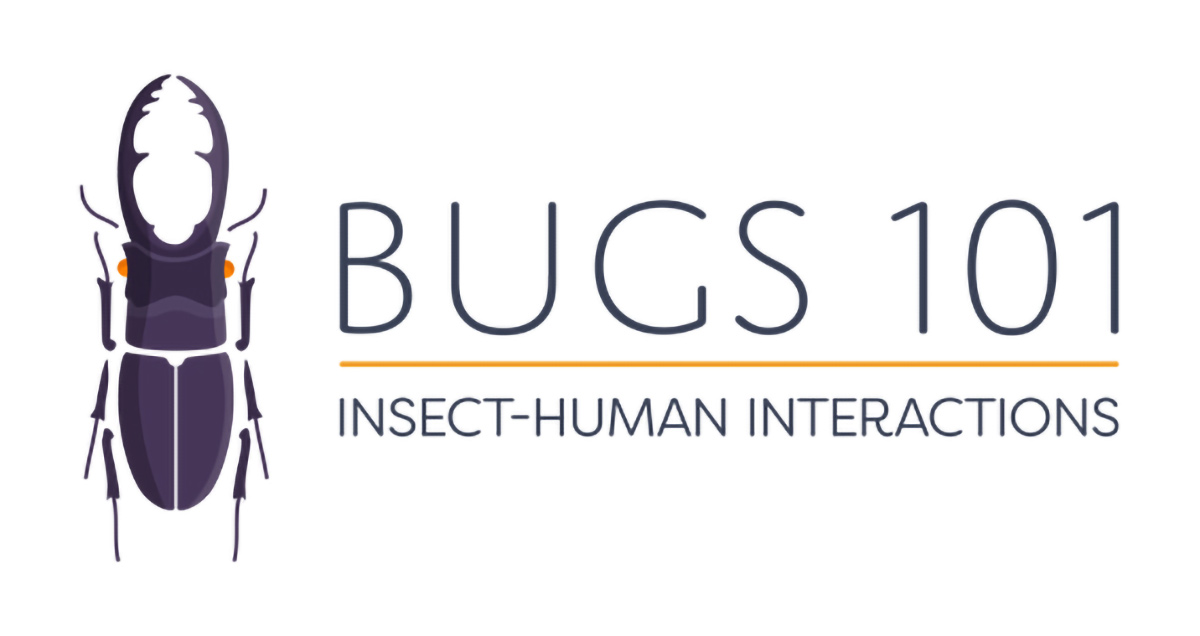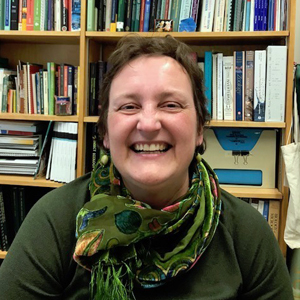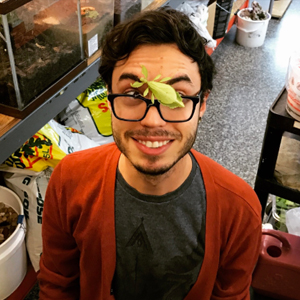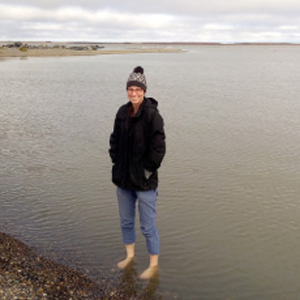
Bugs 101: Insect-Human Interactions
Bugs 101: Insect-Human Interactions provides learners with an introduction to the biology, diversity, and ecology of insects and their roles in human society.
Take online for free
Sign up for free on Coursera today or upgrade to get a certificate.
Take for credit
U of A students can sign up for ENT 101 (3 credits) and access the course through eClass.
About the Course

Bugs 101: Insect-Human Interactions is a 12-lesson course that provides online learners with an introduction to the biology, diversity, and ecology of insects and their roles in human society.
Students will examine the importance of insects in processes that affect humans such as:
- nutrient cycling,
- pollination,
- plant life and crop damage,
- disease transmission,
- and forensics.
 Students will hear from Canadian experts in different insect-related fields-such as forest management and insects in indigenous cultures-and virtually-visit exciting locations such as the Royal Alberta Museum, an Albertan honey farm, and even an insect cafe. Learners will gain an understanding of the helpful and harmful roles of insects in agricultural and forest ecosystems and get a chance to apply the principles of integrated pest management in an interactive learning simulation.
Students will hear from Canadian experts in different insect-related fields-such as forest management and insects in indigenous cultures-and virtually-visit exciting locations such as the Royal Alberta Museum, an Albertan honey farm, and even an insect cafe. Learners will gain an understanding of the helpful and harmful roles of insects in agricultural and forest ecosystems and get a chance to apply the principles of integrated pest management in an interactive learning simulation.
Taking the course as an Alberta junior high or high school student? Bugs 101 content aligns with parts of the Alberta curriculum for Science 7, 9, 10, and 20 and Bio 20 and 30. Learn how U of A MOOCs align with Alberta's secondary curricula.
Learning Outcomes
By the end of the course, students will gain a recognition of the boundless diversity and incredible adaptability of some of the most successful animals to ever inhabit the earth, as well as how humans have made insects integral parts of our cultures, economies, and ecosystems.
After completing this course, you should be able to:
- Describe the evolutionary relationships between insects and their arthropod relatives
- Inventory major groups of insects and their diversity
- Demonstrate evolutionary adaptations that make insects successful
- Discuss insect biology and insect-human interactions
- Evaluate positive and negative interactions between insects and humans
- Propose practical and symbolic roles insects play in human societies
Course Format
Prerequisites:
None! Just an interest in the natural world and a willingness to learn!
For the free Coursera version:
12 graded modules with graded, end-of-module quizzes, supplemented with pass/fail interactive learning objects and formative, in-video questions. Certificates are available upon completion for a fee. Time Commitment: 2-3 hours/week
For the for-credit version:
3 credit version is available to University of Alberta students in Fall and Winter semesters (class capped at 100 students).
Take the course for free & gain insight into the importance of insects
Instructor
Maya Evenden, Professor
Department of Biological Sciences, University of Alberta
Dr. Evenden received an NSERC University Faculty Award to join the University of Alberta in 2003. Her research interests focus on the chemical and behavioural ecology of insects considered to be pests of agriculture, forestry and horticulture in western Canada. The research in her laboratory contributes to the development of sustainable pest management systems. At the University of Alberta, Dr. Evenden teaches: Insect Biology, Insects in Managed Ecosystems, and Chemical Ecology. Dr. Evenden has served as the President of the Entomological Societies of Alberta (2006) and Canada (2010), as well as the International Branch of the Entomological Society of America (2018). She is currently a member of the editorial board on 5 scientific journals. She enjoys being with her family, camping, biking and travelling.
Presenters
Ilan Domnich recently completed his B.Sc. in Animal Biology, with a specialisation in Invertebrate Zoology. A passionate, young entomologist, Ilan's enthusiasm for insects is unparalleled. He has volunteered as an invertebrate specialist at the Royal Alberta Museum for the past six years, caring for live animals in the collection and contributing to outreach events. Ilan also has a degree in Finance from the University of Alberta, with a minor in Accounting. In his free time, Ilan works on his art and enjoys exploring the outdoors.
Joelle Lemmen-Lechelt completed her Ph.D. in Ecology in Maya Evenden's Insect Chemical Ecology Lab at the University of Alberta. She also recently completed a post-doctoral research position at the Swedish University of Agricultural Sciences, where she studied the behaviour and chemical ecology of an invasive fruit fly, the spotted wing Drosophila. Joelle is currently a Biology Instructor at Red Deer College, and believes strongly in the importance of science research, and of using that knowledge for education, outreach and the development of applied technologies. She loves to be outside, and enjoys running, hiking and biking in nature.
Valerie Marshall is a young ecologist who completed her Bachelor of Science in Ecology at the University of Alberta. After working closely with Maya Evenden in her insect chemical ecology lab, Valerie discovered her love for insects. She has also volunteered as an invertebrate specialist at the Royal Alberta Museum, feeding and caring for the predaceous creatures in the Bug Gallery. When not in the field, lab, or office; Valerie likes to hike, climb, read and knit.
Syllabus
Module 1 - Introduction to Insects and their Terrestrial Relatives
- Lesson 1: Arthropods
- Lesson 2: Arthropod Evolution and Classification
- Lesson 3: Small Body Size
- Lesson 4: Metamorphosis, Dispersal, and Reproductive Capabilities
- Lesson 5: Major Insect Orders
- Lesson 6: Insect Collections in Museums
- Lesson 7: Starting Your Insect Collection
Module 2 - The Business of Being an Insect I
- Lesson 1: Insect Body Regions and Head
- Lesson 2: Insect Thorax and Abdomen
- Lesson 3: Digestion and Excretion
- Lesson 4: Circulation and Gas Exchange
Module 3 - The Business of Being an Insect II
- Lesson 1: Nervous System
- Lesson 2: Mate Finding and Courtship
- Lesson 3: Male and Female Reproductive Structures
- Lesson 4: Modes of Reproduction
- Lesson 5: Mating Disruption and SIT
Module 4 - Insect Locomotion
- Lesson 1: Passive and Active Dispersal
- Lesson 2: Insect Musculature
- Lesson 3: Insect Legs and Modifications
- Lesson 4: Insect Wing Structure
- Lesson 5: Insect Wing Modification
- Lesson 6: Insect Flight Muscles
- Lesson 7: Studying Insect Flight
- Lesson 8: Insect Migration
- Lesson 9: Insect Migration - Locusts
- Lesson 10: Insect Migration - Monarch Butterflies
Module 5 - Insects as Decomposers
- Lesson 1: Nutrient Cycling
- Lesson 2: Detritivore Feeding Guides
- Lesson 3: Insect Development
- Lesson 4: Development and Succession in Forensics
Module 6 - Plant Feeding and Impacts of Herbivory
- Lesson 1: Coevolution & Ecological Fitting
- Lesson 2: Levels of Diet Specialisation
- Lesson 3: Plant Defences
- Lesson 4: Plant Feeding Guilds
- Lesson 5: Insect as Herbivorous Pests
Module 7 - Pollination and Beekeeping
- Lesson 1: Pollination
- Lesson 2: Pollinator Challenges and Importance
- Lesson 3: Apiculture
- Lesson 4: Honey Bee Eusociality and Castes
- Lesson 5: Honey Bee Biology
- Lesson 6: Honey Bee Communication
- Lesson 7: Threats to Honey Bees
Module 8 - Insects and Disease
- Lesson 1: Etiological Agents
- Lesson 2: Disease Vectors
- Lesson 3: Arthropod-borne Human Diseases
- Lesson 4: Arthropod-borne Animal Diseases
- Lesson 5: Arthropod-borne Plant Diseases
Module 9 - Sustainable Human-Insect Interactions - IPM
- Lesson 1: Integrated Pest Management
- Lesson 2: IPM - Chemical Control
- Lesson 3: Types of Insecticides
- Lesson 4: Advantages and Limitations of Insecticides
Module 10 - Sustainable Human-Insect Interactions - IPM (Biological and Cultural Control)
- Lesson 1: Biological Control
- Lesson 2: Types of Biological Control
- Lesson 3: Pros and Cons of Biological Control
- Lesson 4: Cultural Control
Module 11 - Insect Conservation
- Lesson 1: Conservation of Insect Diversity
- Lesson 2: The Changing World and Insects
- Lesson 3: The Changing Climate and Insects
- Lesson 4: Invasive Species and Overcollecting
- Lesson 5: Conserving and Managing Insect Diversity
- Lesson 6: Challenges in Insect Conservation
Module 12 - Insects in Human Culture
- Lesson 1: Myths and Symbols
- Lesson 2: Art, Literature, and Film
- Lesson 3: Services and Products
- Lesson 4: Science and Technology
- Lesson 5: Entomophagy



